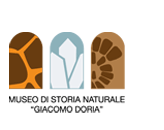The collections of Invertebrates comprise upwards of 2.5 million specimens, excluding Insects. Most of the specimens are preserved in ethanol but there are also dry-preserved specimens, mainly shells, corals, gorgonias, sponges and madrepores.
Among marine species, the collection of Porifera (sponges) is particularly important as it comprises more than 200 types. This great wealth derives essentially from the collections of Gustavo Pulitzer-Finali, who, from 1980 to 1992, donated to the Museum his collection of Mediterranean and tropical specimens.
The collection of Arachnida (spiders, scorpions, acari and other smaller groups) is one of the richest in the Museum, comprising roughly 350,000 specimens, mostly of exotic origin. Above all, the Burmese, Malay and Papua specimens have been the basis for the studies carried out by Tord Tamerlan Thorell, a Swedish specialist hosted for years by Giacomo Doria, who described hundreds of new species comprised in the collection.
The collection of Crustacea comprises about 30,000 specimens, with a good representation of all the major groups.
The collection of Myriapoda (Chilopoda or centipedes and Diplopoda or millipedes) is extremely rich, with about 100,000 specimens, the result of collections made in non-European regions by explorers linked to the Museum. One of the specialists who studied these materials was Filippo Silvestri (1873-1949), whose impressive collection with more than 500 types is contained in 2,000 glass jars.
The first core of the collection of Mollusca dates back to 1857, when Giacomo Doria, then seventeen, began with his brother Marcello the “Collection of the Doria Brothers”, gathering significant specimens, mainly near La Spezia.
The Malacological collection amounts to nearly 600,000 dry-preserved shells, but also includes a section preserved in ethanol, dedicated mainly to Cephalopods (octopuses, cuttlefish and squids).




